Progressive Gradient Pruning for Classification, Detection and Domain Adaptation
Le Thanh Nguyen-Meidine,
Eric Granger,
Marco Pedersoli,
Madhu Kiran,
Louis-Antoine Blais-Morin
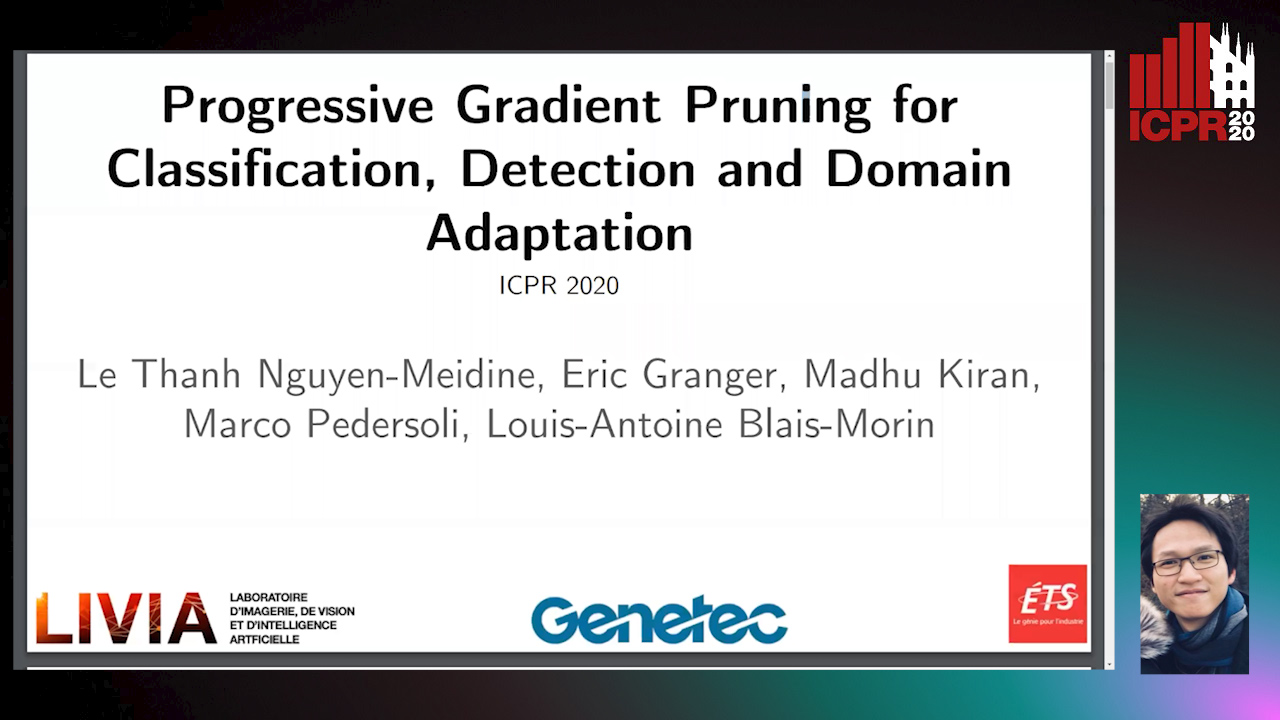
Auto-TLDR; Progressive Gradient Pruning for Iterative Filter Pruning of Convolutional Neural Networks
Similar papers
HFP: Hardware-Aware Filter Pruning for Deep Convolutional Neural Networks Acceleration
Fang Yu, Chuanqi Han, Pengcheng Wang, Ruoran Huang, Xi Huang, Li Cui

Auto-TLDR; Hardware-Aware Filter Pruning for Convolutional Neural Networks
Abstract Slides Poster Similar
Learning to Prune in Training via Dynamic Channel Propagation
Shibo Shen, Rongpeng Li, Zhifeng Zhao, Honggang Zhang, Yugeng Zhou

Auto-TLDR; Dynamic Channel Propagation for Neural Network Pruning
Abstract Slides Poster Similar
A Discriminant Information Approach to Deep Neural Network Pruning

Auto-TLDR; Channel Pruning Using Discriminant Information and Reinforcement Learning
Abstract Slides Poster Similar
Slimming ResNet by Slimming Shortcut
Donggyu Joo, Doyeon Kim, Junmo Kim

Auto-TLDR; SSPruning: Slimming Shortcut Pruning on ResNet Based Networks
Abstract Slides Poster Similar
Softer Pruning, Incremental Regularization
Linhang Cai, Zhulin An, Yongjun Xu

Auto-TLDR; Asymptotic SofteR Filter Pruning for Deep Neural Network Pruning
Abstract Slides Poster Similar
Activation Density Driven Efficient Pruning in Training
Timothy Foldy-Porto, Yeshwanth Venkatesha, Priyadarshini Panda
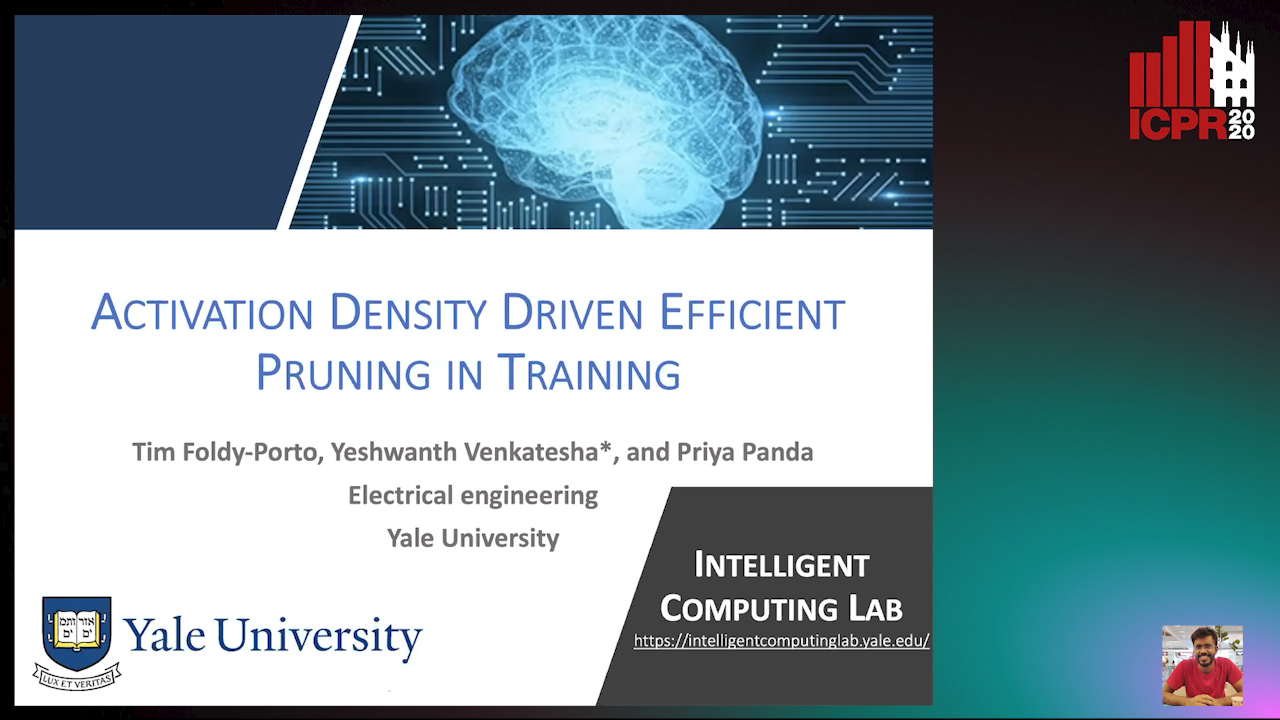
Auto-TLDR; Real-Time Neural Network Pruning with Compressed Networks
Abstract Slides Poster Similar
Filter Pruning Using Hierarchical Group Sparse Regularization for Deep Convolutional Neural Networks
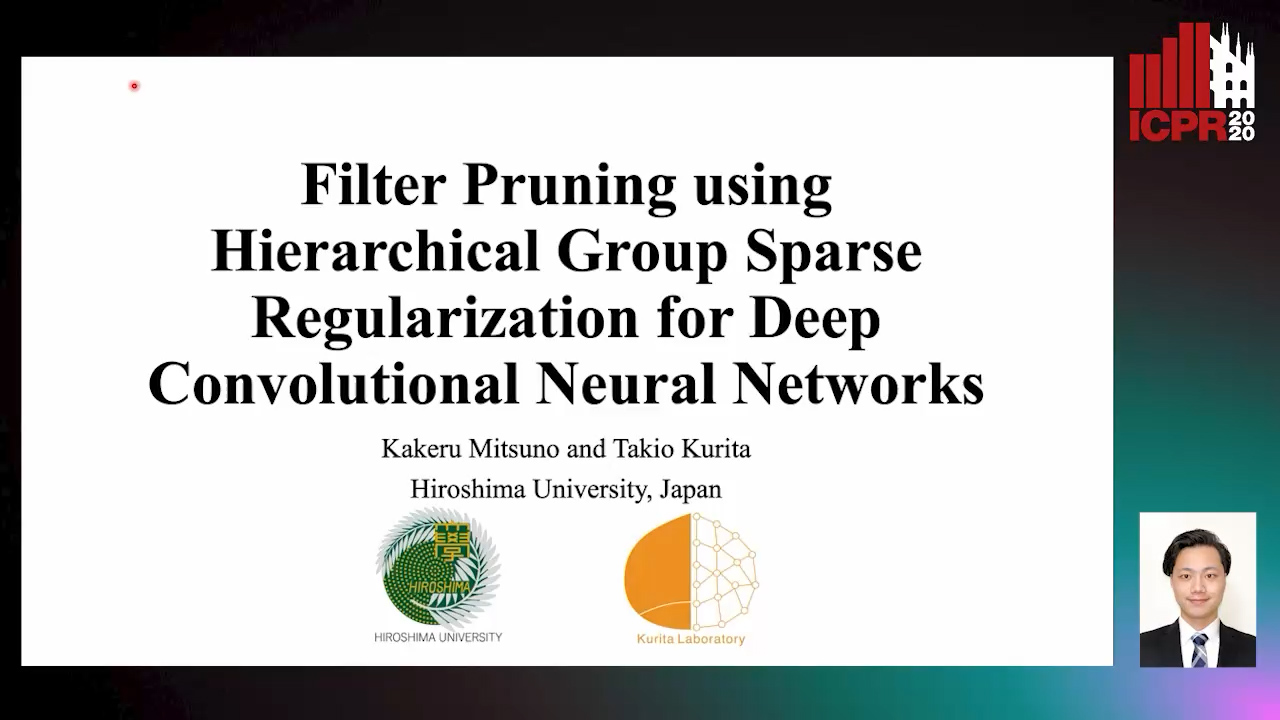
Auto-TLDR; Hierarchical Group Sparse Regularization for Sparse Convolutional Neural Networks
Abstract Slides Poster Similar
Neuron-Based Network Pruning Based on Majority Voting
Ali Alqahtani, Xianghua Xie, Ehab Essa, Mark W. Jones

Auto-TLDR; Large-Scale Neural Network Pruning using Majority Voting
Abstract Slides Poster Similar
Exploiting Non-Linear Redundancy for Neural Model Compression
Muhammad Ahmed Shah, Raphael Olivier, Bhiksha Raj

Auto-TLDR; Compressing Deep Neural Networks with Linear Dependency
Abstract Slides Poster Similar
Attention Based Pruning for Shift Networks
Ghouthi Hacene, Carlos Lassance, Vincent Gripon, Matthieu Courbariaux, Yoshua Bengio

Auto-TLDR; Shift Attention Layers for Efficient Convolutional Layers
Abstract Slides Poster Similar
On the Information of Feature Maps and Pruning of Deep Neural Networks
Mohammadreza Soltani, Suya Wu, Jie Ding, Robert Ravier, Vahid Tarokh

Auto-TLDR; Compressing Deep Neural Models Using Mutual Information
Abstract Slides Poster Similar
Learning Sparse Deep Neural Networks Using Efficient Structured Projections on Convex Constraints for Green AI
Michel Barlaud, Frederic Guyard

Auto-TLDR; Constrained Deep Neural Network with Constrained Splitting Projection
Abstract Slides Poster Similar
Compression of YOLOv3 Via Block-Wise and Channel-Wise Pruning for Real-Time and Complicated Autonomous Driving Environment Sensing Applications
Jiaqi Li, Yanan Zhao, Li Gao, Feng Cui
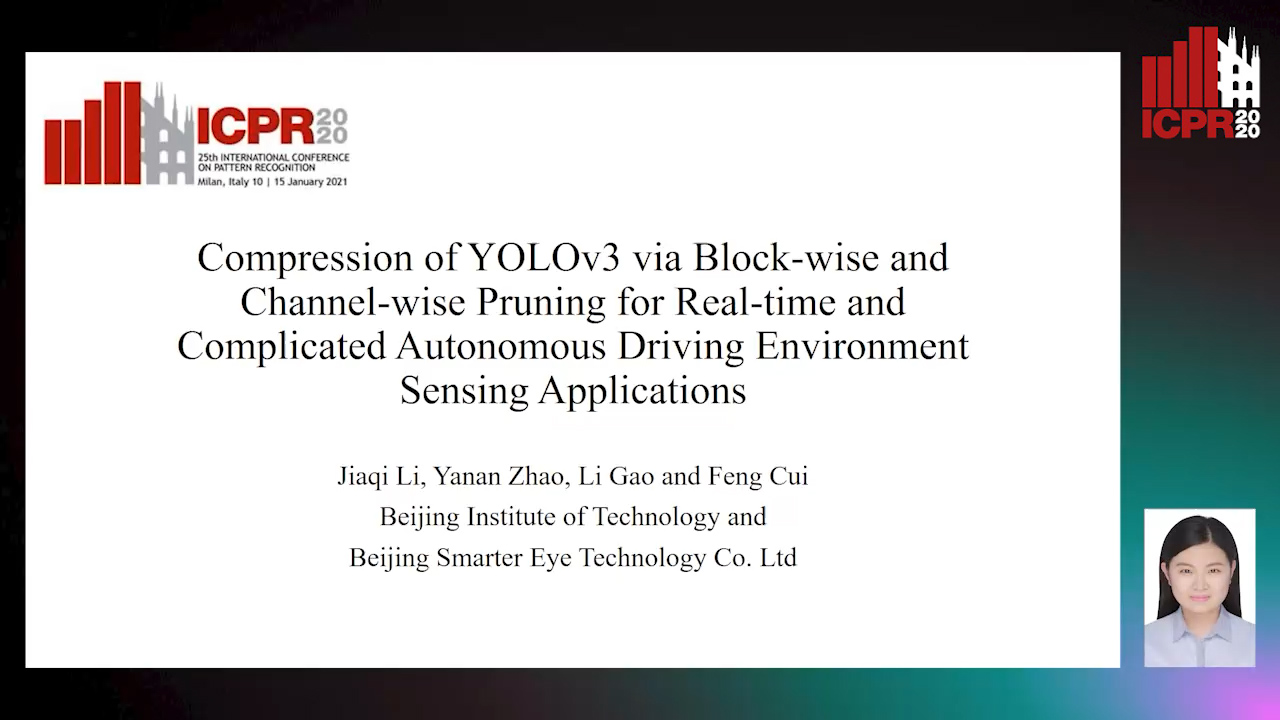
Auto-TLDR; Pruning YOLOv3 with Batch Normalization for Autonomous Driving
Abstract Slides Poster Similar
Speeding-Up Pruning for Artificial Neural Networks: Introducing Accelerated Iterative Magnitude Pruning
Marco Zullich, Eric Medvet, Felice Andrea Pellegrino, Alessio Ansuini
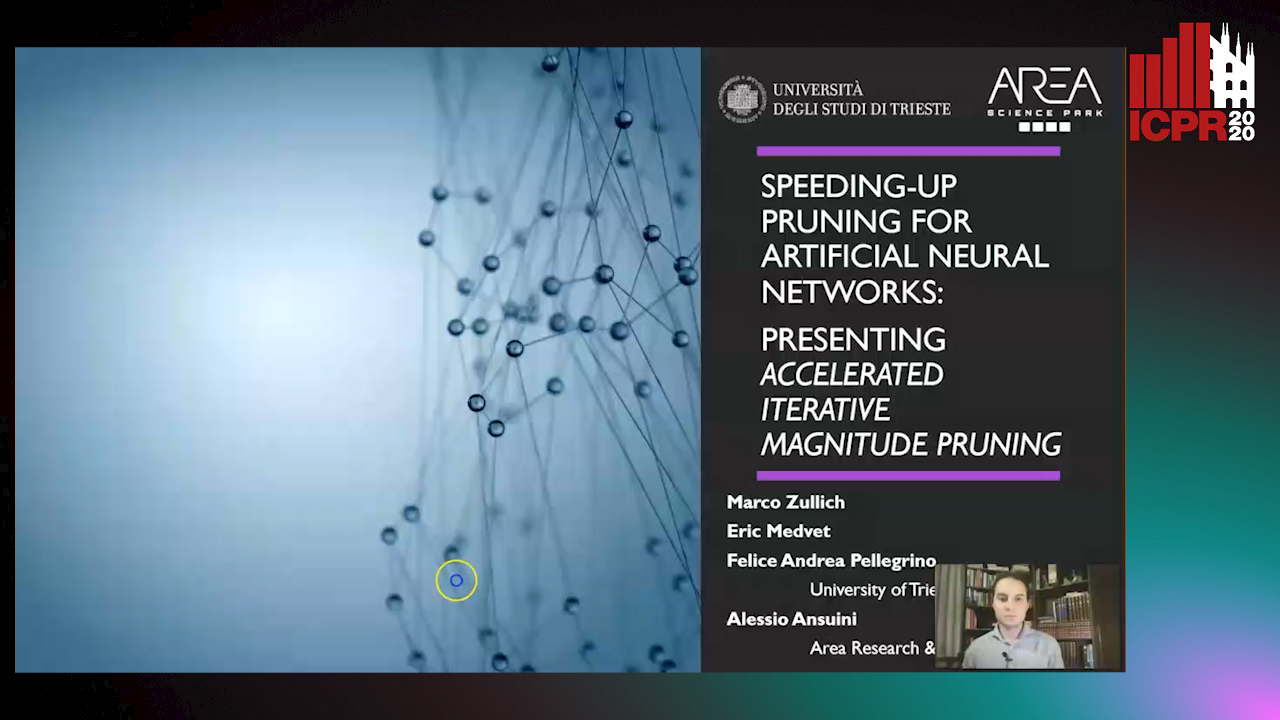
Auto-TLDR; Iterative Pruning of Artificial Neural Networks with Overparametrization
Abstract Slides Poster Similar
MINT: Deep Network Compression Via Mutual Information-Based Neuron Trimming
Madan Ravi Ganesh, Jason Corso, Salimeh Yasaei Sekeh
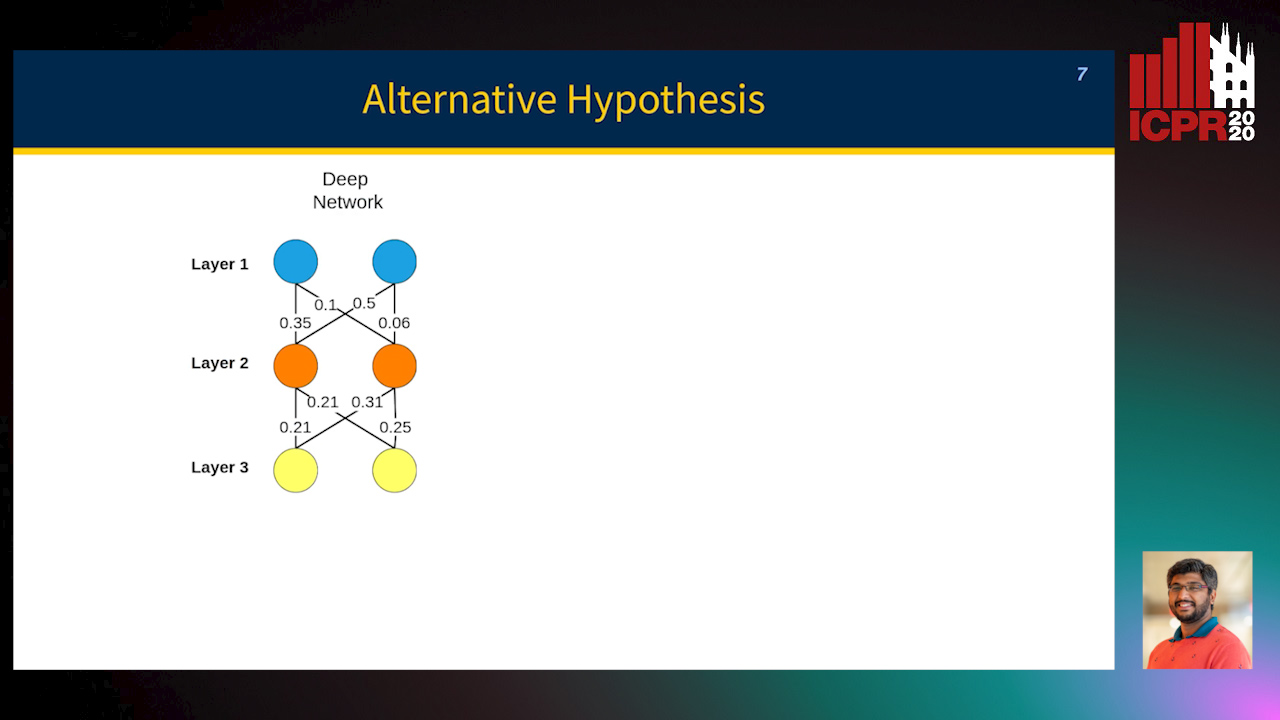
Auto-TLDR; Mutual Information-based Neuron Trimming for Deep Compression via Pruning
Abstract Slides Poster Similar
Compression Strategies and Space-Conscious Representations for Deep Neural Networks
Giosuè Marinò, Gregorio Ghidoli, Marco Frasca, Dario Malchiodi

Auto-TLDR; Compression of Large Convolutional Neural Networks by Weight Pruning and Quantization
Abstract Slides Poster Similar
Exploiting Elasticity in Tensor Ranks for Compressing Neural Networks
Jie Ran, Rui Lin, Hayden Kwok-Hay So, Graziano Chesi, Ngai Wong

Auto-TLDR; Nuclear-Norm Rank Minimization Factorization for Deep Neural Networks
Abstract Slides Poster Similar
Object Detection in the DCT Domain: Is Luminance the Solution?
Benjamin Deguerre, Clement Chatelain, Gilles Gasso

Auto-TLDR; Jpeg Deep: Object Detection Using Compressed JPEG Images
Abstract Slides Poster Similar
Stage-Wise Neural Architecture Search
Artur Jordão, Fernando Akio Yamada, Maiko Lie, William Schwartz
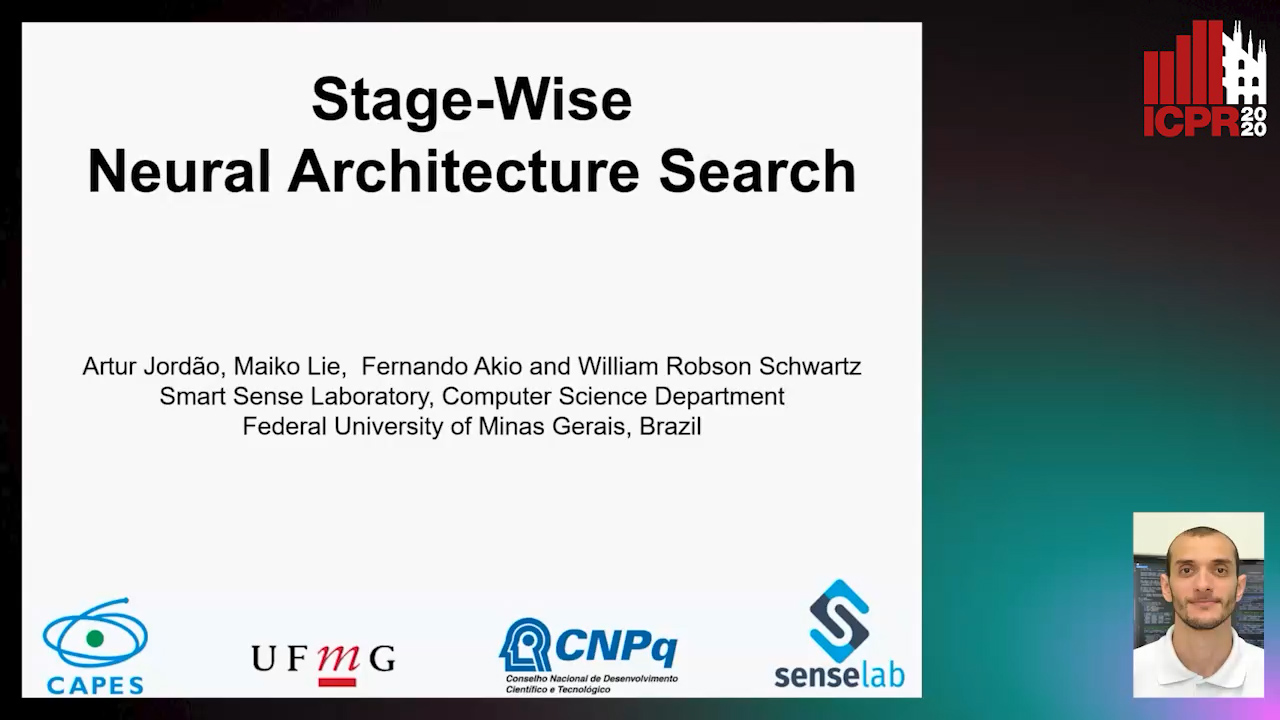
Auto-TLDR; Efficient Neural Architecture Search for Deep Convolutional Networks
Abstract Slides Poster Similar
Rethinking of Deep Models Parameters with Respect to Data Distribution
Shitala Prasad, Dongyun Lin, Yiqun Li, Sheng Dong, Zaw Min Oo

Auto-TLDR; A progressive stepwise training strategy for deep neural networks
Abstract Slides Poster Similar
WeightAlign: Normalizing Activations by Weight Alignment
Xiangwei Shi, Yunqiang Li, Xin Liu, Jan Van Gemert

Auto-TLDR; WeightAlign: Normalization of Activations without Sample Statistics
Abstract Slides Poster Similar
Dynamic Multi-Path Neural Network
Yingcheng Su, Yichao Wu, Ken Chen, Ding Liang, Xiaolin Hu

Auto-TLDR; Dynamic Multi-path Neural Network
E-DNAS: Differentiable Neural Architecture Search for Embedded Systems
Javier García López, Antonio Agudo, Francesc Moreno-Noguer

Auto-TLDR; E-DNAS: Differentiable Architecture Search for Light-Weight Networks for Image Classification
Abstract Slides Poster Similar
Channel Planting for Deep Neural Networks Using Knowledge Distillation
Kakeru Mitsuno, Yuichiro Nomura, Takio Kurita

Auto-TLDR; Incremental Training for Deep Neural Networks with Knowledge Distillation
Abstract Slides Poster Similar
Resource-efficient DNNs for Keyword Spotting using Neural Architecture Search and Quantization
David Peter, Wolfgang Roth, Franz Pernkopf

Auto-TLDR; Neural Architecture Search for Keyword Spotting in Limited Resource Environments
Abstract Slides Poster Similar
Enhancing Semantic Segmentation of Aerial Images with Inhibitory Neurons
Ihsan Ullah, Sean Reilly, Michael Madden

Auto-TLDR; Lateral Inhibition in Deep Neural Networks for Object Recognition and Semantic Segmentation
Abstract Slides Poster Similar
Neural Compression and Filtering for Edge-assisted Real-time Object Detection in Challenged Networks
Yoshitomo Matsubara, Marco Levorato

Auto-TLDR; Deep Neural Networks for Remote Object Detection Using Edge Computing
Abstract Slides Poster Similar
Supervised Domain Adaptation Using Graph Embedding
Lukas Hedegaard, Omar Ali Sheikh-Omar, Alexandros Iosifidis

Auto-TLDR; Domain Adaptation from the Perspective of Multi-view Graph Embedding and Dimensionality Reduction
Abstract Slides Poster Similar
VPU Specific CNNs through Neural Architecture Search
Ciarán Donegan, Hamza Yous, Saksham Sinha, Jonathan Byrne

Auto-TLDR; Efficient Convolutional Neural Networks for Edge Devices using Neural Architecture Search
Abstract Slides Poster Similar
Improved Residual Networks for Image and Video Recognition
Ionut Cosmin Duta, Li Liu, Fan Zhu, Ling Shao

Auto-TLDR; Residual Networks for Deep Learning
Abstract Slides Poster Similar
Not All Domains Are Equally Complex: Adaptive Multi-Domain Learning
Ali Senhaji, Jenni Karoliina Raitoharju, Moncef Gabbouj, Alexandros Iosifidis

Auto-TLDR; Adaptive Parameterization for Multi-Domain Learning
Abstract Slides Poster Similar
A Modified Single-Shot Multibox Detector for Beyond Real-Time Object Detection
Georgios Orfanidis, Konstantinos Ioannidis, Stefanos Vrochidis, Anastasios Tefas, Ioannis Kompatsiaris

Auto-TLDR; Single Shot Detector in Resource-Restricted Systems with Lighter SSD Variations
Abstract Slides Poster Similar
Towards Low-Bit Quantization of Deep Neural Networks with Limited Data
Yong Yuan, Chen Chen, Xiyuan Hu, Silong Peng
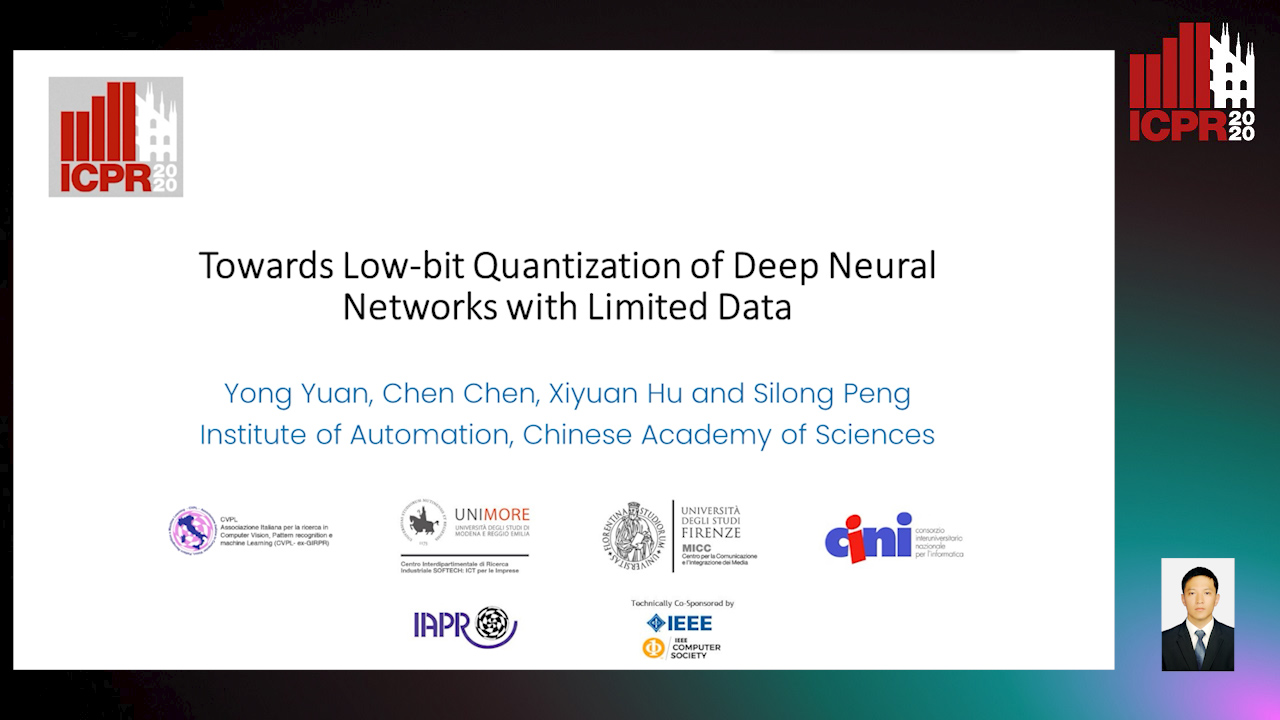
Auto-TLDR; Low-Precision Quantization of Deep Neural Networks with Limited Data
Abstract Slides Poster Similar
Fine-Tuning DARTS for Image Classification
Muhammad Suhaib Tanveer, Umar Karim Khan, Chong Min Kyung
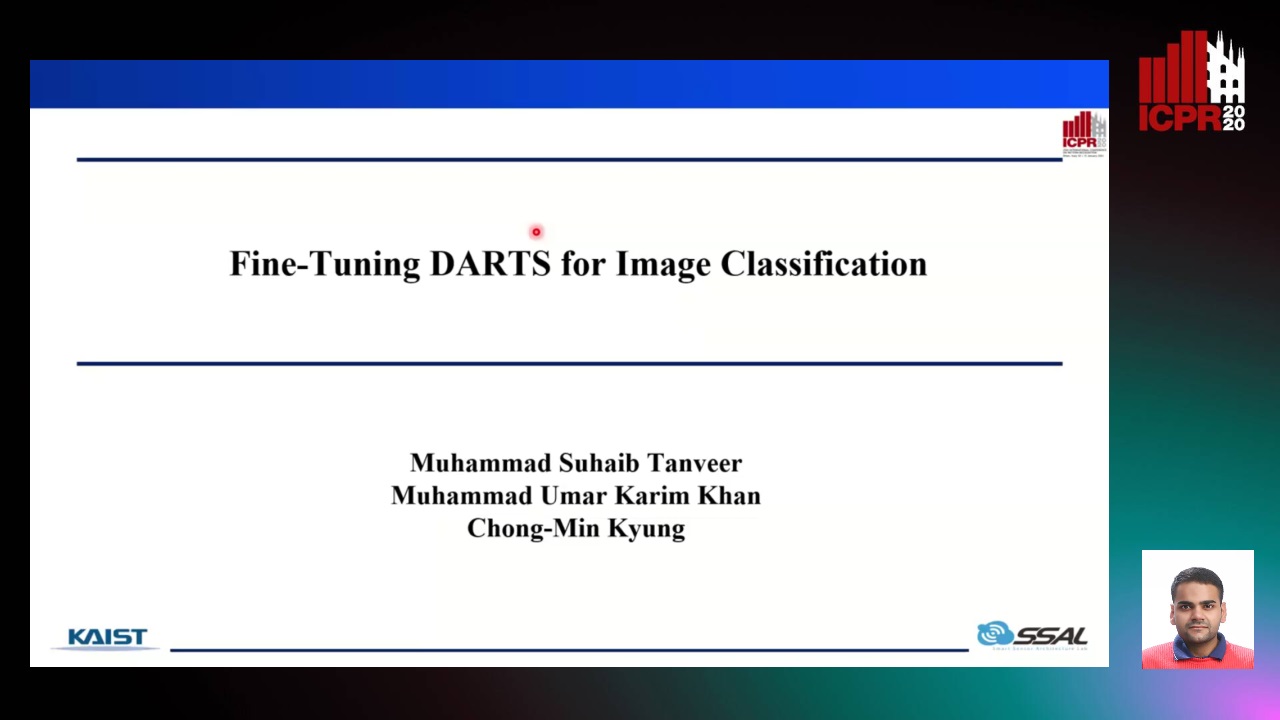
Auto-TLDR; Fine-Tune Neural Architecture Search using Fixed Operations
Abstract Slides Poster Similar
ResNet-Like Architecture with Low Hardware Requirements
Elena Limonova, Daniil Alfonso, Dmitry Nikolaev, Vladimir V. Arlazarov

Auto-TLDR; BM-ResNet: Bipolar Morphological ResNet for Image Classification
Abstract Slides Poster Similar
NAS-EOD: An End-To-End Neural Architecture Search Method for Efficient Object Detection
Huigang Zhang, Liuan Wang, Jun Sun, Li Sun, Hiromichi Kobashi, Nobutaka Imamura
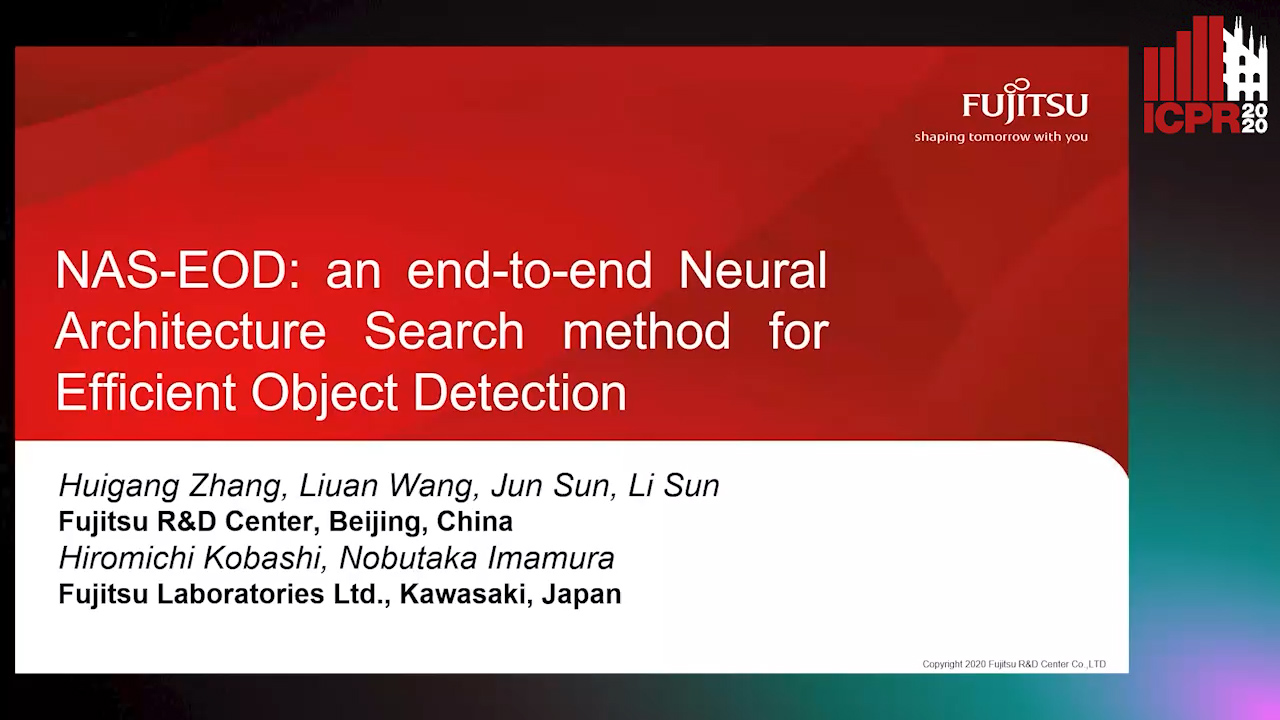
Auto-TLDR; NAS-EOD: Neural Architecture Search for Object Detection on Edge Devices
Norm Loss: An Efficient yet Effective Regularization Method for Deep Neural Networks
Theodoros Georgiou, Sebastian Schmitt, Thomas Baeck, Wei Chen, Michael Lew

Auto-TLDR; Weight Soft-Regularization with Oblique Manifold for Convolutional Neural Network Training
Abstract Slides Poster Similar
How Does DCNN Make Decisions?
Yi Lin, Namin Wang, Xiaoqing Ma, Ziwei Li, Gang Bai

Auto-TLDR; Exploring Deep Convolutional Neural Network's Decision-Making Interpretability
Abstract Slides Poster Similar
A Simple Domain Shifting Network for Generating Low Quality Images
Guruprasad Hegde, Avinash Nittur Ramesh, Kanchana Vaishnavi Gandikota, Michael Möller, Roman Obermaisser

Auto-TLDR; Robotic Image Classification Using Quality degrading networks
Abstract Slides Poster Similar
SiamMT: Real-Time Arbitrary Multi-Object Tracking
Lorenzo Vaquero, Manuel Mucientes, Victor Brea
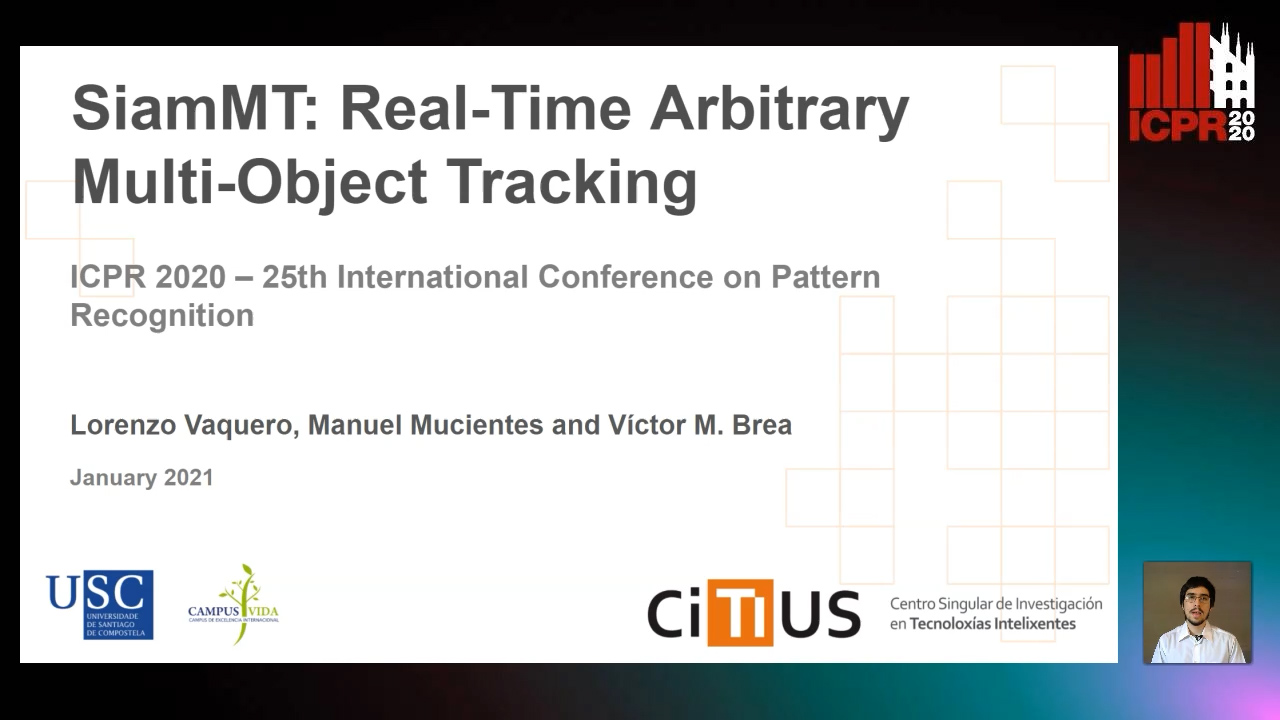
Auto-TLDR; SiamMT: A Deep-Learning-based Arbitrary Multi-Object Tracking System for Video
Abstract Slides Poster Similar
Fast Implementation of 4-Bit Convolutional Neural Networks for Mobile Devices
Anton Trusov, Elena Limonova, Dmitry Slugin, Dmitry Nikolaev, Vladimir V. Arlazarov
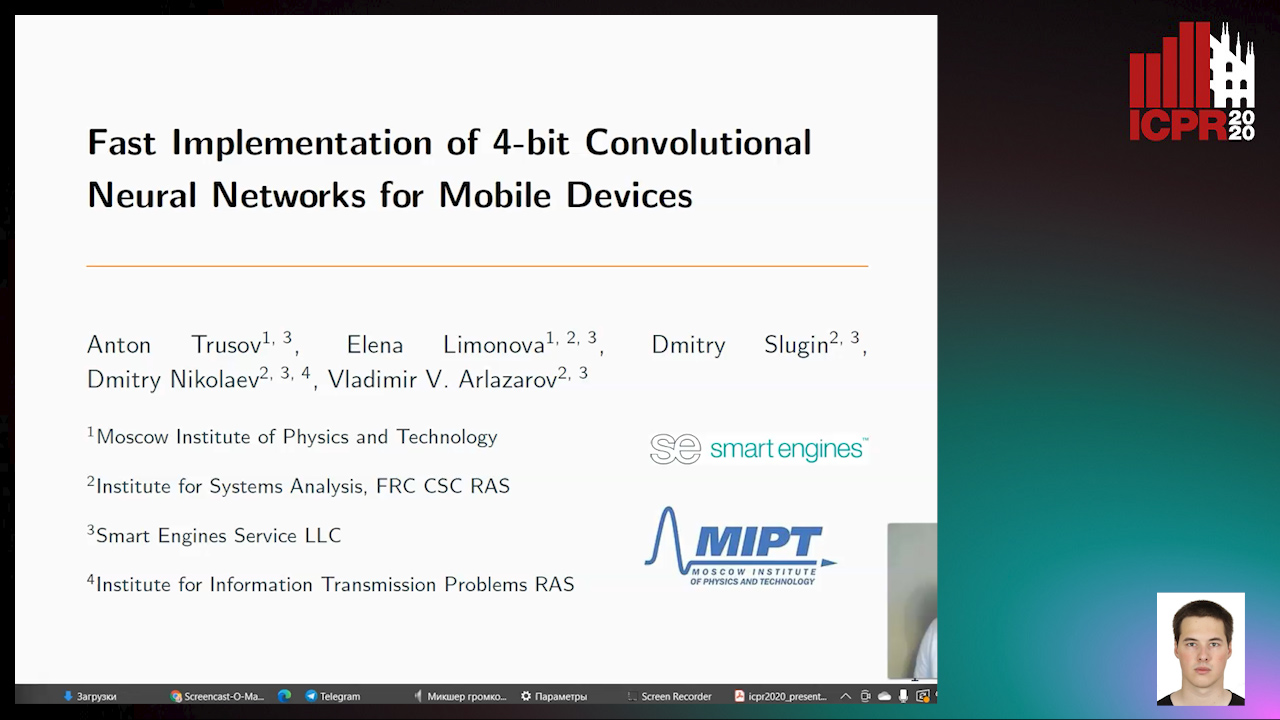
Auto-TLDR; Efficient Quantized Low-Precision Neural Networks for Mobile Devices
Abstract Slides Poster Similar
Generalization Comparison of Deep Neural Networks Via Output Sensitivity
Mahsa Forouzesh, Farnood Salehi, Patrick Thiran

Auto-TLDR; Generalization of Deep Neural Networks using Sensitivity
Fast and Accurate Real-Time Semantic Segmentation with Dilated Asymmetric Convolutions
Leonel Rosas-Arias, Gibran Benitez-Garcia, Jose Portillo-Portillo, Gabriel Sanchez-Perez, Keiji Yanai

Auto-TLDR; FASSD-Net: Dilated Asymmetric Pyramidal Fusion for Real-Time Semantic Segmentation
Abstract Slides Poster Similar
Compact CNN Structure Learning by Knowledge Distillation
Waqar Ahmed, Andrea Zunino, Pietro Morerio, Vittorio Murino
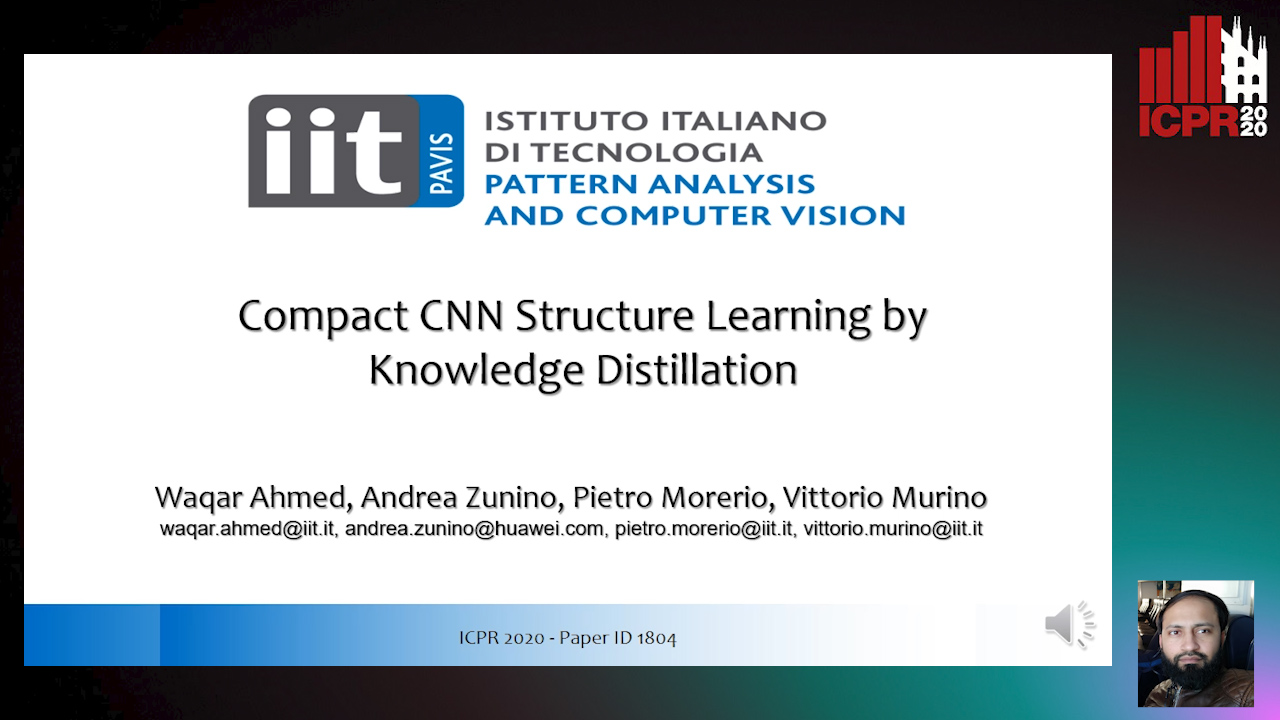
Auto-TLDR; Knowledge Distillation for Compressing Deep Convolutional Neural Networks
Abstract Slides Poster Similar
Building Computationally Efficient and Well-Generalizing Person Re-Identification Models with Metric Learning
Vladislav Sovrasov, Dmitry Sidnev

Auto-TLDR; Cross-Domain Generalization in Person Re-identification using Omni-Scale Network
Adaptive Image Compression Using GAN Based Semantic-Perceptual Residual Compensation
Ruojing Wang, Zitang Sun, Sei-Ichiro Kamata, Weili Chen

Auto-TLDR; Adaptive Image Compression using GAN based Semantic-Perceptual Residual Compensation
Abstract Slides Poster Similar
A Close Look at Deep Learning with Small Data

Auto-TLDR; Low-Complex Neural Networks for Small Data Conditions
Abstract Slides Poster Similar
Progressive Learning Algorithm for Efficient Person Re-Identification
Zhen Li, Hanyang Shao, Liang Niu, Nian Xue

Auto-TLDR; Progressive Learning Algorithm for Large-Scale Person Re-Identification
Abstract Slides Poster Similar